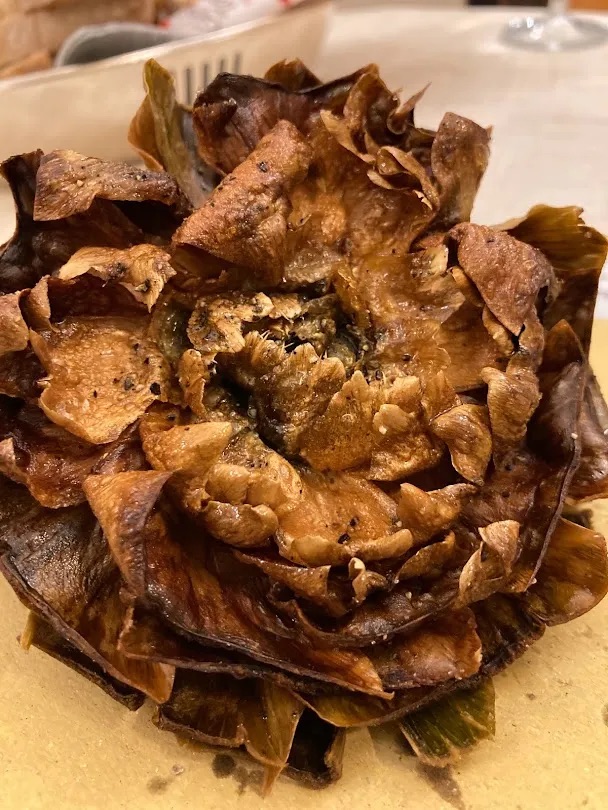
By Francesco Bianchini
Could I have asked for more from life than to be born in Rome? Despite my scattered and ambivalent ties to the city—where I have only ever lived in brief spells—I carry Rome not only in my heart and mind, but also on my palate. I’ve often wondered why, unlike other capital cities, it has never been a mecca for gourmets. For me, who’s always had little patience for culinary frills, the answer is simple: Romans are easy to please. Even the aristocracy was never so affected as to keep a French-trained monsù at home, just to stay fashionable.

The stuff of legends…Romulus and Remus and the nurturing she-wolf
As Ada Boni wrote in the preface to her Cucina Romana (1929), “the Roman has a cordial dislike for overly elaborate dishes and, being a stern conservative, welcomes with suspicion anything that strays too far from his customary fare.” To this I would add: good cooking relies on excellent local products, and on the golden rule of less is more. Roman cuisine—based on ingredients that others might discard—is the pure art of making do. It works wonders with the humblest wild greens, with offal, pigskin, oxtail, and tongue.
I mean no offense to Rome’s neighbors when I speak of the cucina romanesca, for I’m really talking about blurred borders—local traditions that overlap and differ only in the choice of one herb over another. Like all regional cuisine, it’s hard to reproduce elsewhere for lack of the very ingredients that give it soul. Yes, you can now find pale, limp rocket in every supermarket, but the wild rughetta that sprouts in dry cracks—slender, lance-shaped, bitter and peppery on the tongue—is part of every Roman’s DNA.

Al Pompiere, in the Roman Jewish quarter since 1928
The Roman trattoria is a world of its own: blond wooden frames surrounding glass doors with chrome or brass handles; no boudoir decor but brisk practicality: square tables with white tablecloths and squat chairs. In the kitchen and dining room, everyone is family, and there’s always a cheerful caciara (a happy racket), not the reverent hush of a French restaurant, where you feel as if you’ve walked into a chapel. And the Roman dialect you hear around you is real—not the slurred underworld variety, nor the nasal, affected tones of the uptown pariolino.
Roman dishes include puntarelle (a variety of chicory dressed with olive oil, garlic, and anchovies); gnocchi di semolino; Romanesco broccoli sautéed in the pan; true supplì—rice croquettes stuffed with mozzarella that stretches into a string like a telephone wire when you bite them—and all the great classics of lamb; saltimbocca, fried baccalà, the famed quinto quarto (nose-to-tail offal), and many others besides. But there are two bold flavors I can’t resist describing further.
First, the artichoke—specifically the round, tender cimarolo or mammola varieties. In Rome, you eat them fried alla giudia or braised alla romana. The first, the Jewish-style artichoke, is not an everyday affair—it takes a sure hand at frying in the right earthenware pan, and a host of little tricks. I once ate it in a trattoria in the Roman ghetto, served open like a peony, laid on a folded napkin to catch the excess oil.

Artichoke alla giudia
Come late winter, markets fill with these beauties, and I buy them in odd numbers, as with flowers, and keep them standing in a vase with water until I’m ready to clean them—no vegetable is lovelier to behold. Artichokes darken easily, and darken your fingers too, so I wear gloves to peel away the tough leaves, trimming them down, then soaking them in water with lemon juice. Under cold running water, I gently pry open each heart, fill each one with minced mint, garlic, salt, and pepper. Then I set them head down in hot oil, splash them with good white wine, flip them upright on their stems, half-cover them with broth, and let them barely simmer for half an hour, under a lid sealed with a sheet of parchment. If the artichoke is fresh, it turns out tender—not fibrous—savory and delicately tangy from the lemon and wine.

Floral arrangement
The second taste I treasure is tripe—an acquired flavor that I don’t expect to share with the multitudes, despite some tentative evangelizing. I usually eat it alone, like a guilty pleasure. I’m not sure I’ve always loved it, but over the years it has become a comfort food—and it is comforting to prepare. For me, tripe is a mantra, a meditation, a therapy.

An acquired taste…trippa alla romana
Supermarket tripe is usually bleached to look less intimidating, but real devotees buy it straight from the butcher, where it keeps its natural brownish hue. I make my soffritto with patriotic zeal—onion, carrot, and celery lined up like the Italian tricolor—and add the tripe, cut into strips. I let the water evaporate, then deglaze with white wine. Next, add a can of peeled tomatoes, crushed by hand, and a sprinkle of Roman mint, salt, and pepper. Cooking time varies: an hour for pre-cooked tripe, twice as long if it is raw. I prefer to let the stew burble on the stove, checking from time to time just to breathe its dense aroma, and to stare into the pot as if it were a mandala. At the bottom, the floating strips make a composite geometry in a red interstellar space, swirling around in a cosmic dance. In truth, I believe this is what the universe looked like after the Big Bang. In the beginning… there was tripe.

Dining and Cooking